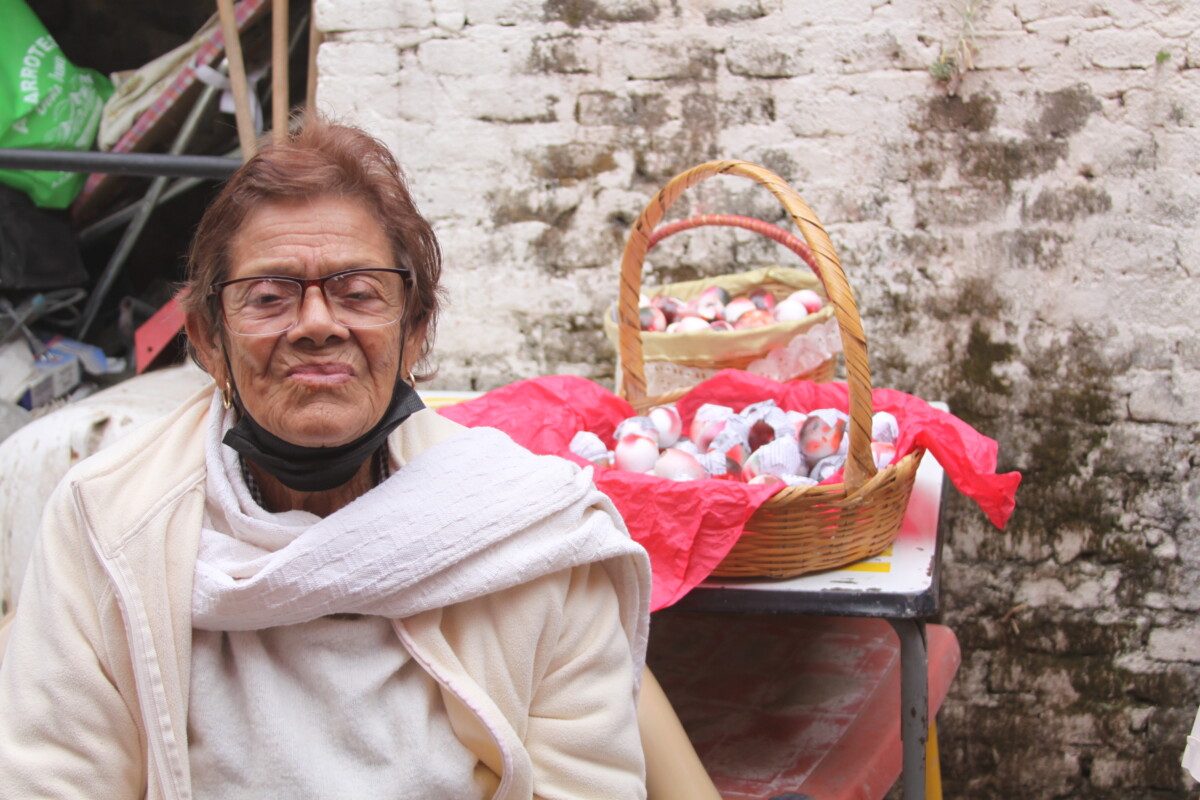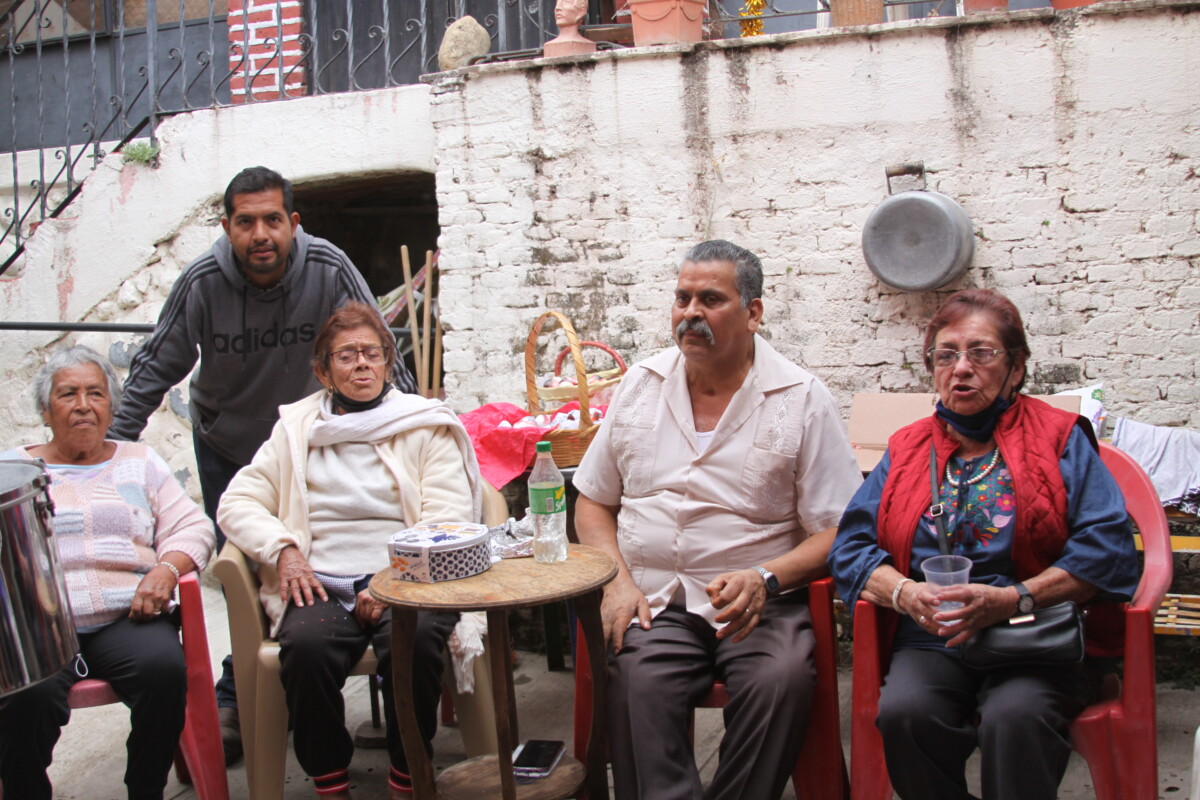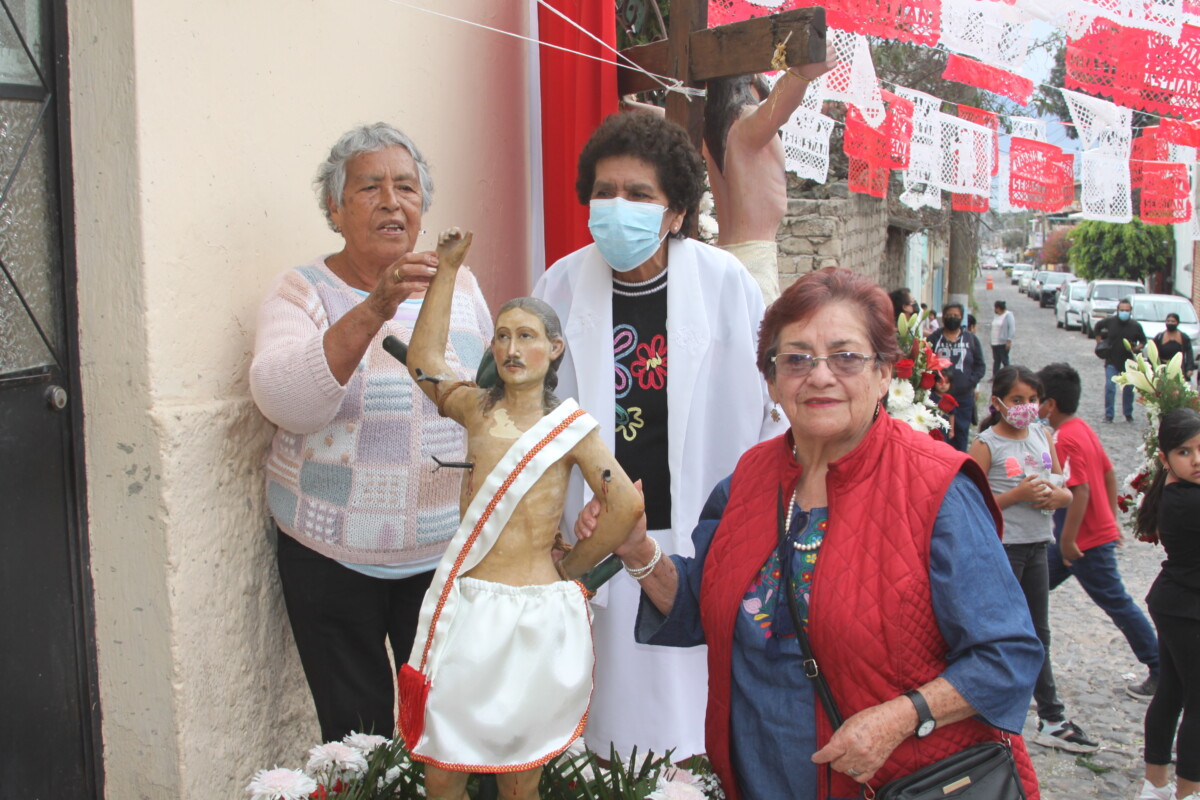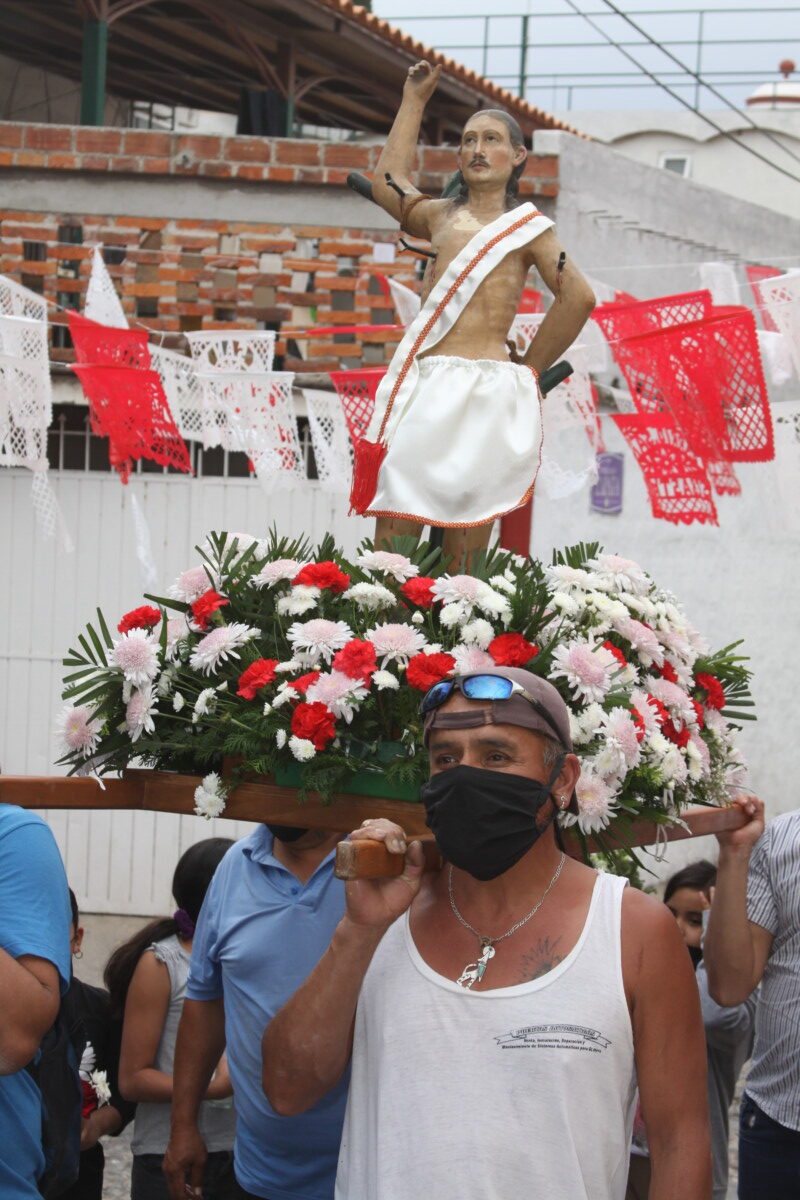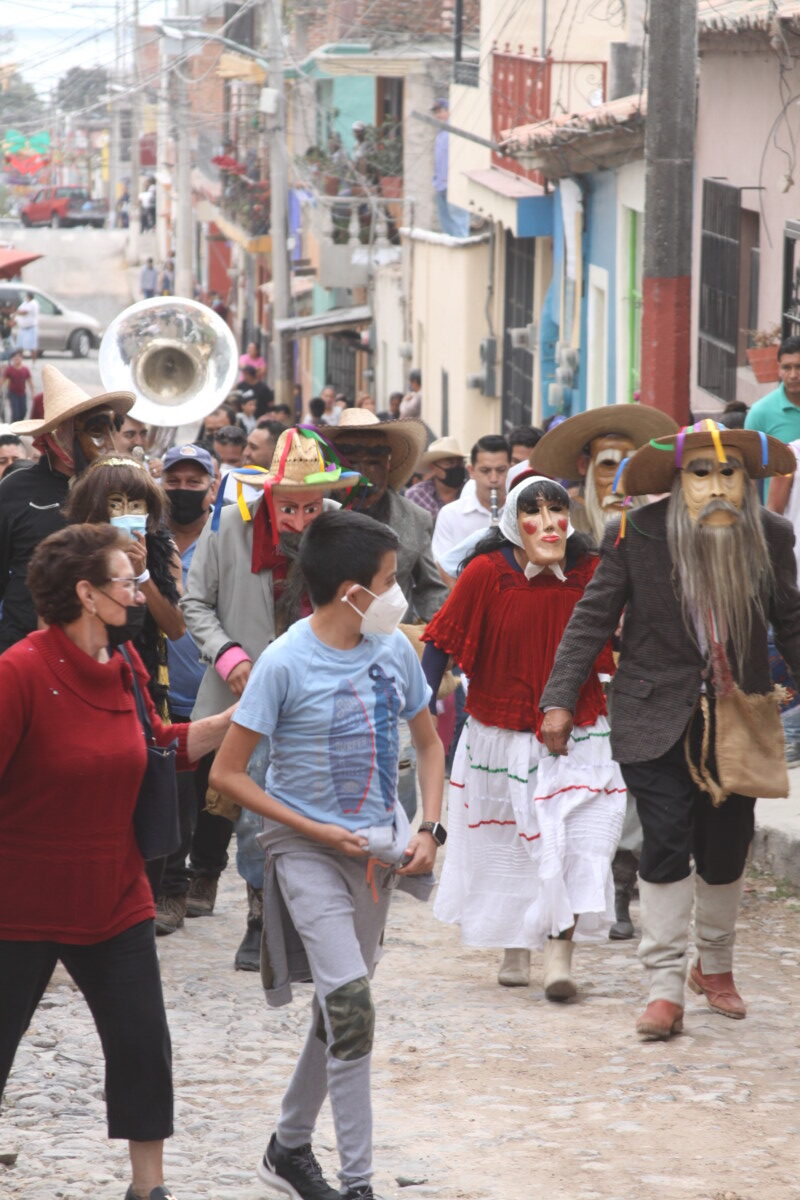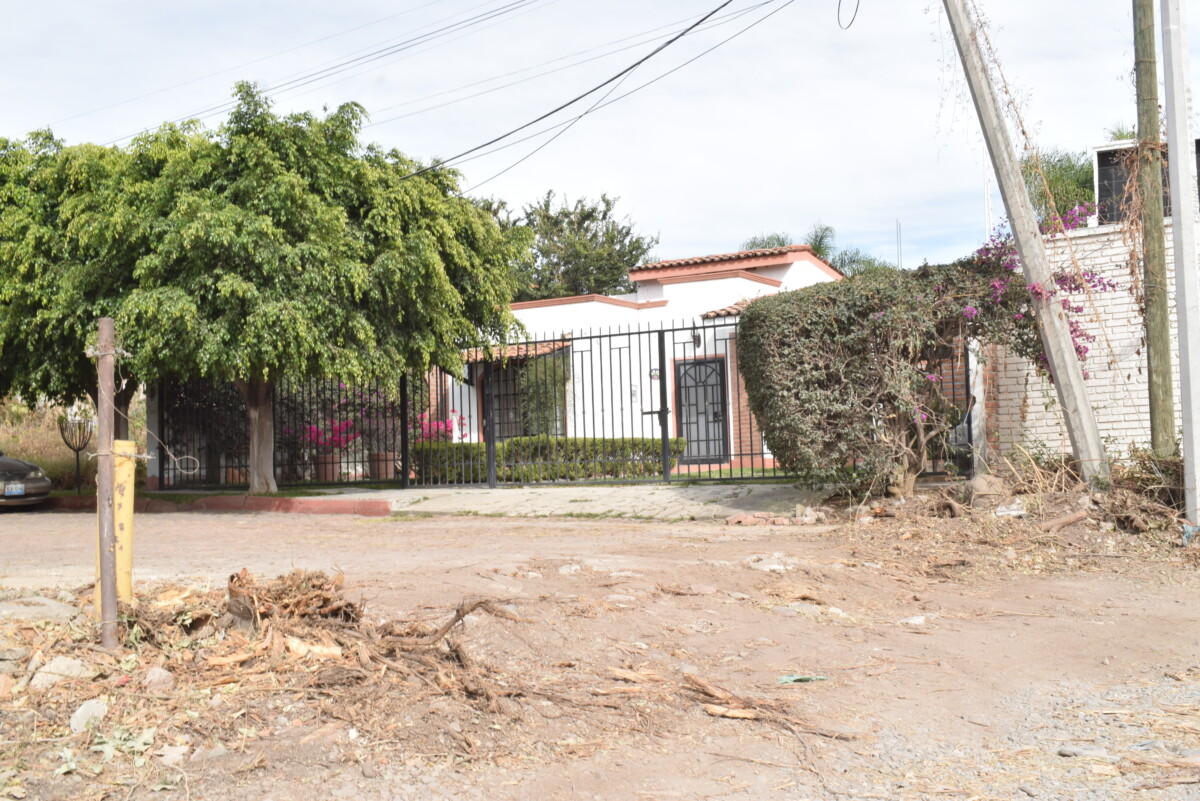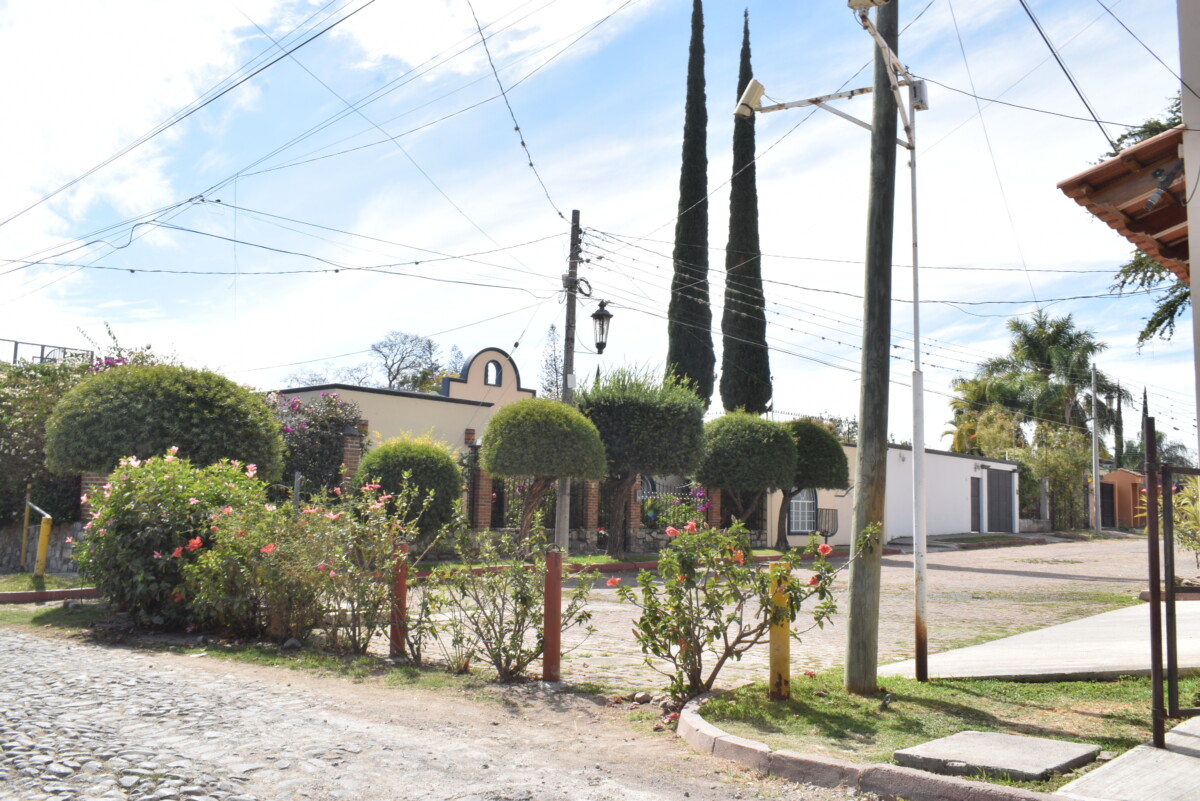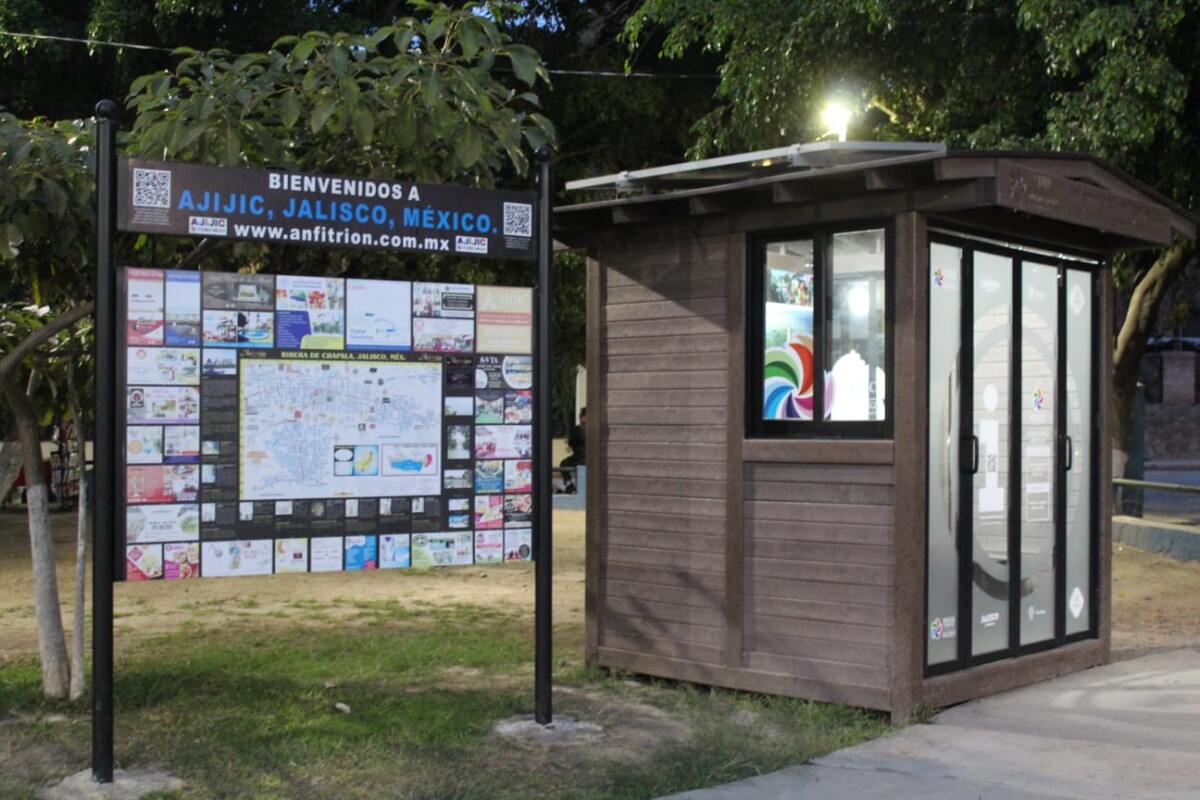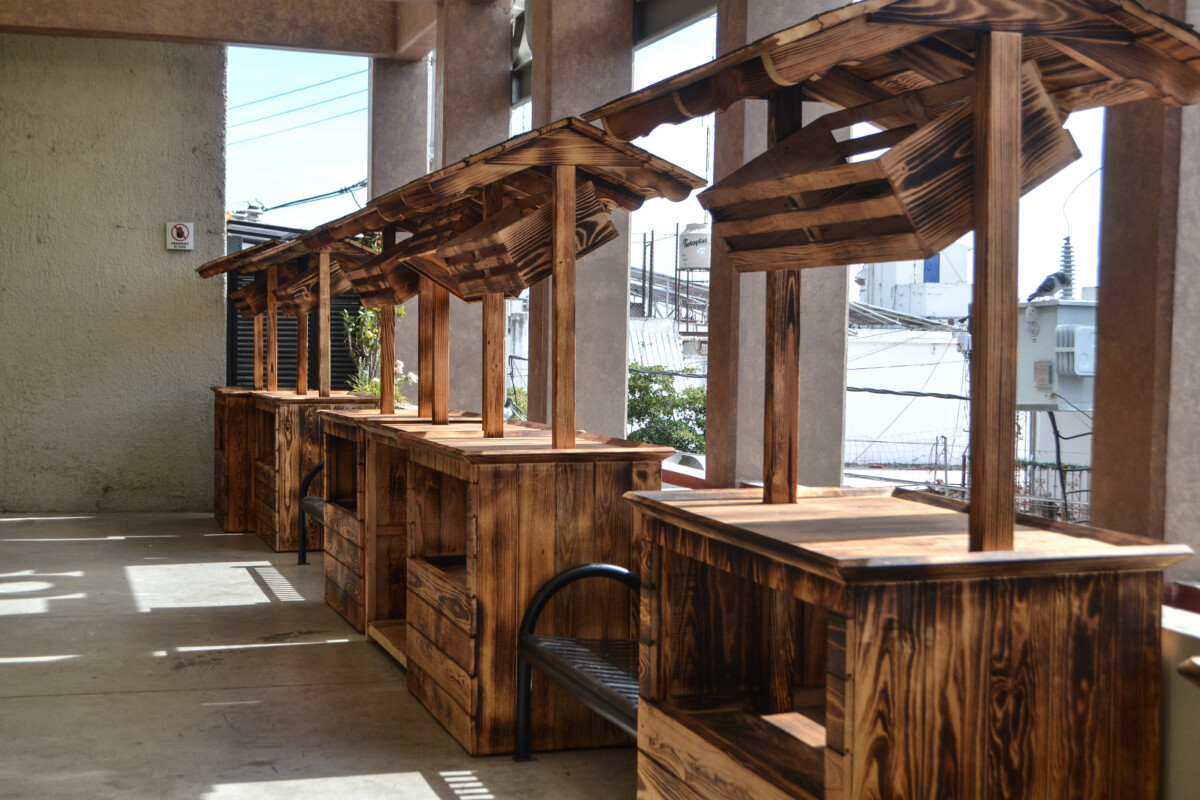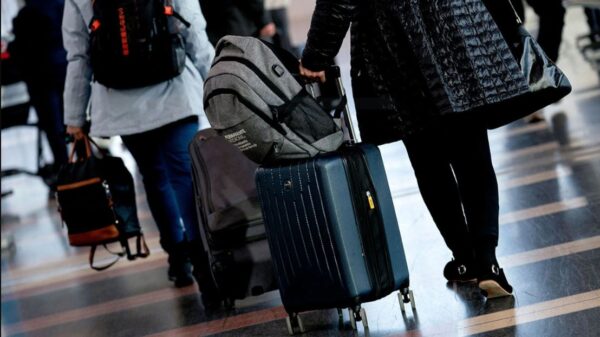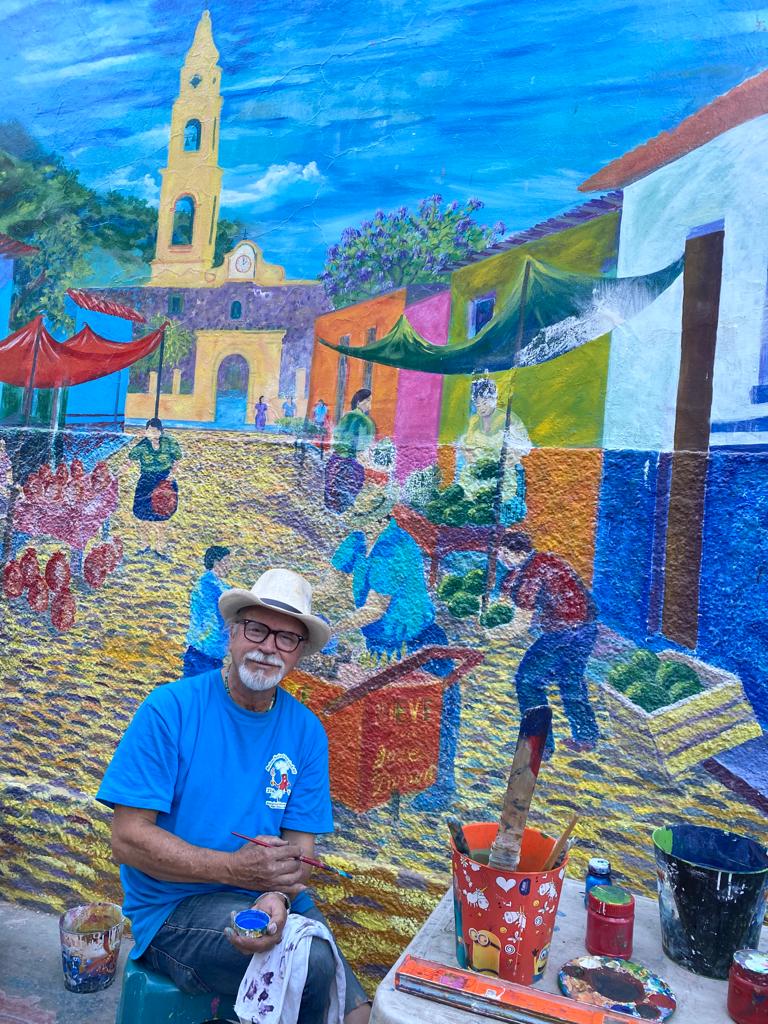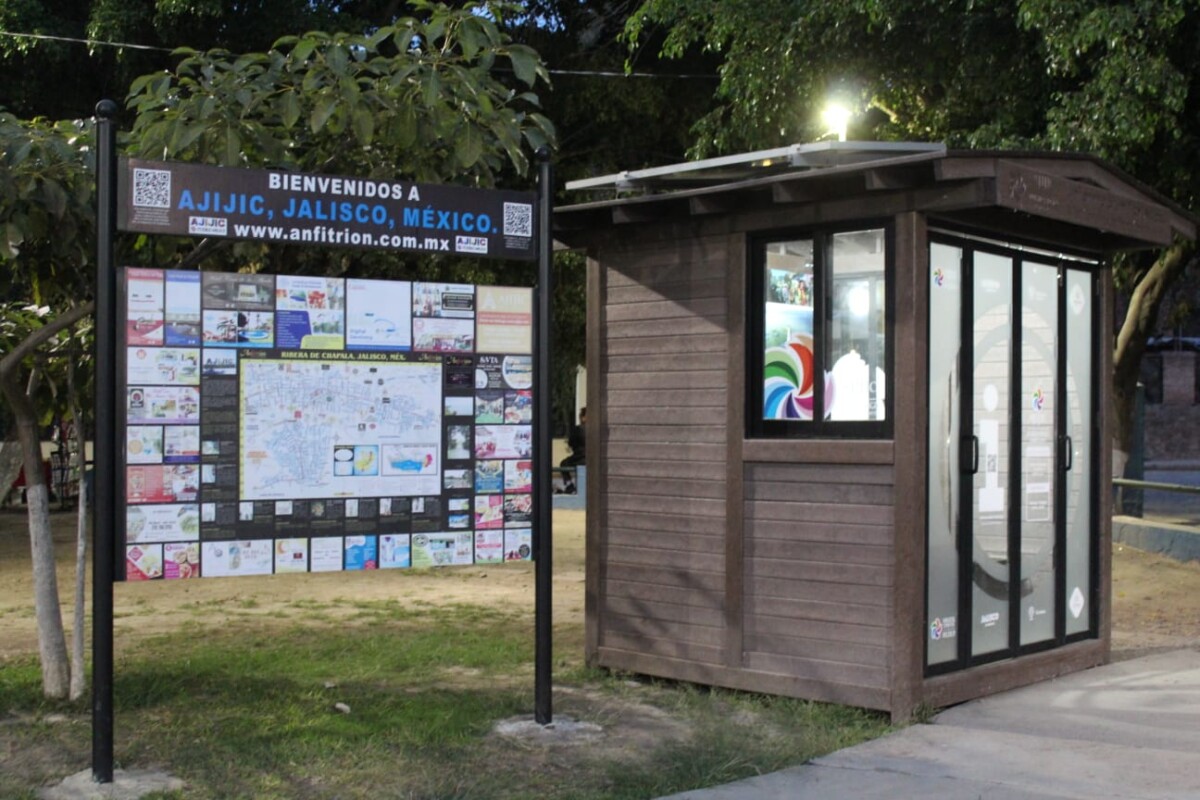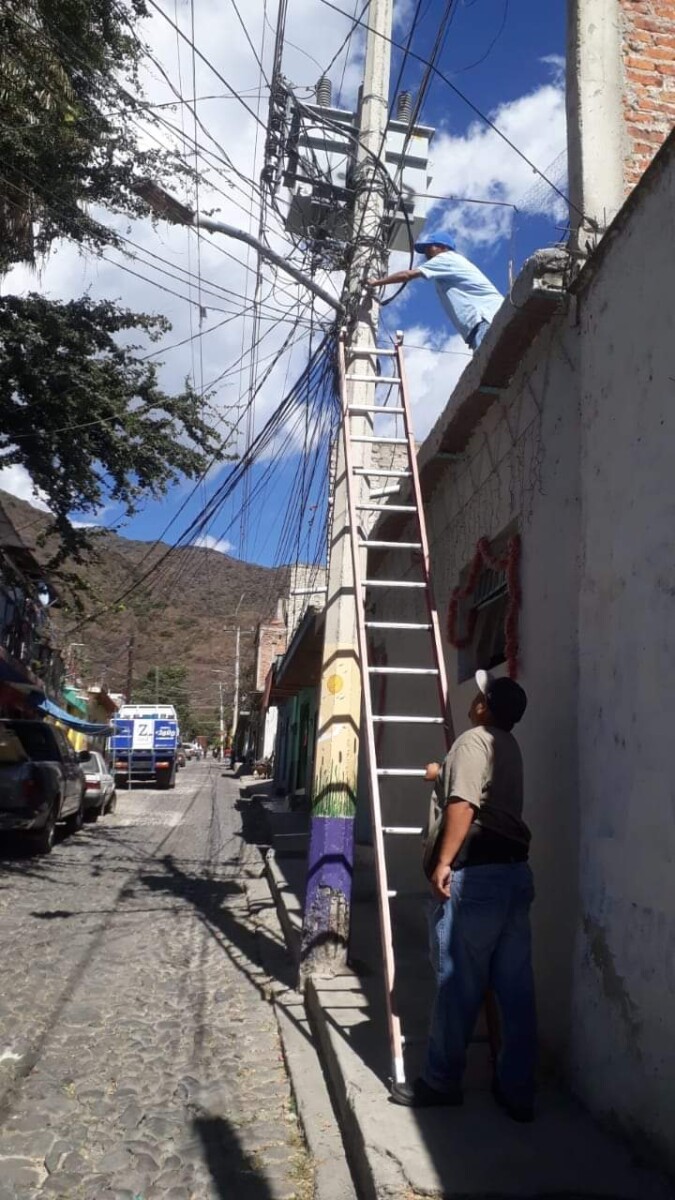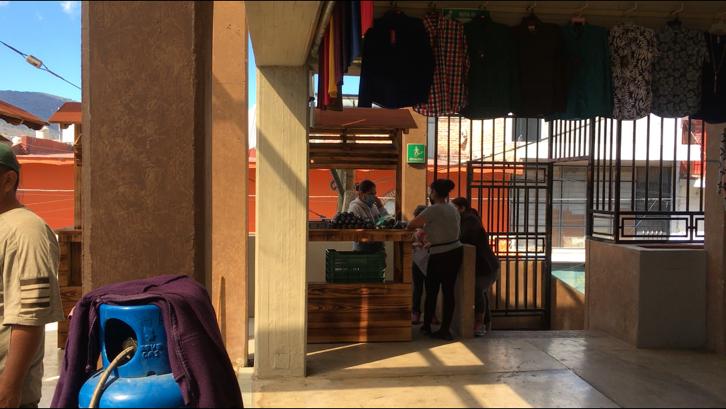Turismo
Lakeside Chronicles: The feast of San Sebastian
Doña Irene prepared the eggshells with confetti weeks before
María del Refugio Reynozo Medina (Ajijic) – January 20 is the most awaited day for the devotees of San Sebastian.
Doña Irene is 82 years old. As a child, she accompanied her parents to the celebration of San Sebastian. She has lines of time on her face; most of them are hints of a smile, because Doña Irene smiles a lot. Her chatter is a contagious melody. She welcomes the visitor as if she had seen him yesterday and as if she already knew him. “Let’s have a little refreshment,» she says. Her conversation invites you to stay and contemplate the afternoon by the cobblestone street.
Although now it is not like other years, she is looking forward to the feast of San Sebastian with joy and she is providing almost 30 chickens for the mole.
Irene Martínez Cervantes lives in the San Sebastián neighborhood in Ajijic.
She remembers her parents’ veneration for the patron saint San Sebastian, whom they celebrated every year on January 20. Her family used to organize this celebration and she decided to continue it, despite the Covid-19 pandemic restrictions.
Seventy-five-year-old Don Antonio Arceo, another of the organizers, follows the tradition of his ancestors. He remembers that in the past, the sponsor of the festival was by invitation.
Two or three months before the festival, those who had been in charge the previous year would select another person to continue the tradition. The previous organizers would visit the new person, bringing a carafe of tamarind or pomegranate punch as a gift. They would bury the tightly closed punch for up to two months and add pieces of quince when it was unburied. When the drink was ready, the new sponsor agreed to assume the responsibility of covering the expenses of the drink, the food, the music and the tachihual bread (a traditional bread loaf). The new sponsor recruited ten to twelve people to help him. The following year he would make the same invitation to another acquaintance.
A handshake, a shared drink of punch and a word as a guarantee was enough to close the commitment. So says the song that is engraved in the memory of the faithful, by dint of repeating it every year during music and confetti.
This charge I give them
to those who remain.
So that they never forget it
and that they pay for it.
Weeks before January 20, Doña Irene starts to paint eggshells and fills them with confetti for the papaqui (the throwing of eggshells and confetti to the rhythm of the song of San Sebastian) That is why one of the mischievous stanzas says:
Poor San Sebastian
who never knew underpants.
The first ones he bought
he exchanged them for eggshells.
On the day of the procession Doña Irene is sitting inside the courtyard with some of her co-workers and close friends. She watches with pleasure the parade of men, women and children who come for the plates of food. Women and children carry towers of plates of mole, beans and rice to their homes. Some men take their rations and packages of tortillas to eat sitting on the sidewalks.
At the corner of Emiliano Zapata and Marcos Castellanos streets sits the altar to San Sebastian. There are two figures. The smaller one measuring approximately one meter and brought from the church the previous day. The other is one about a meter and a half that Doña Irene had sculpted. They are in the middle of a large arch of red carnations and chrysanthemums, on a table covered with white tablecloths.
“There are few people now,» says one of the attendants. Before the pandemic, food was served at tables set up along the street, and casseroles with rice and mole accompanied the procession.
Music has been playing since last night at San Sebastian. Not just one band, «it’s a group,» a young man tells me. Members of different bands come to play for the patron saint.
One woman and seven men make up the cast to liven up the procession. After three o’clock in the afternoon, they begin to prepare the small wooden platform where the smallest sculpture of San Sebastian, loaned from the parish, will be placed. He has starred in the festival for as long as they can remember.
Saint Sebastian is shown with one arm backwards tied to a pole and the other bent towards the heavens. His right index finger is missing. He has a taciturn look, curly shoulder-length hair, a mustache, thin outlined eyebrows and a cracked chest and arm. Five arrows are embedded in his body, which, according to the history of the saints, recall the rain of arrows he received in his martyrdom.
Doña Irene approaches with her companions to see him off, they surround him and talk in his ear, because he will not visit them again until next year. Little by little about 50 people arrive. The band begins to play. Suddenly the first sayaco (traditional, cross-dressing, masked characters who throw confetti or flour) appears wearing a work shirt, khaki colored jacket, boots, hat, and a backpack. He wears a long raw-colored wooden mask, from his cheeks emerges a long beard, bushy eyebrows and a straw-colored mustache.
Six more sayacos arrive dressed as exotic women. One of them, aided by a pair of balloons, shows off her bulging breasts under a flowered blouse. Another wears a blouse of gold and black threads with a tiara of sequins. The youngest sayaco looks like a teenaged girl wearing a scarf over her crimson-plated mask and a black dress edged with blue lace. She stomps her booties on the uneven streets.
The sayacos lead the procession dancing and waving their circular skirts non-stop, followed by the band. The sculpture of San Sebastian follows, carried on the shoulders of four men. As it passes through the elementary school, the students come out to watch through the entrance gate. The sayacos bring their masks close to the gate while the little ones laugh.
San Sebastian is returned to the parish amidst cheers and applause. The sayacos do not enter the temple and they wait outside to return in procession with the music of the band.
Now the Sayacos are the absolute masters of the parade, they take out fists of confetti from their backpacks to throw at the women. Up on a balcony a little girl hides between her mother’s legs, a sayaco jumps to scare her, the little girl cries and the woman laughs and hugs her. A group of about 30 children taunt the sayacos, run and urge them to chase them. Upon their arrival in the heart of the neighborhood outside Doña Irene’s house, the music continues to play and the Sayacos dance a little. Less than 30 attendees begin to break shells filled with confetti on their heads while the music plays. There Bertha Baron intones with two accompanists the traditional song to San Sebastian.
Say goodbye to the meat
and also to the sausage.
Because Ash Wednesday is coming
Ash Wednesday is coming.
And so, ends this celebration in which many collaborate, where adults play like children in a rain of confetti, all singing the traditional, fervent and irreverent song.
Translated by Nita Rudy
Mirasol streets reopen to the public
Calle Los Tulipanes with the new chain preventing passage, January 26.
Jazmín Stengel.– The streets that for a long time were privatized, were reopened to the public by personnel of the Municipality of Chapala, on Friday, January 21, causing annoyance among the neighbors of the Mirasol subdivision.
At the request of residents south of Riberas del Pilar, Chapala Mobility and municipal government personnel used heavy machinery to open the streets Los Lirios, Los Tulipanes and Tabachines of the subdivision, giving way to the general public. Las Malvas was the only street that was blocked due to some bushes that were planted on the site.
This action annoyed the neighbors of Mirasol. A group of 23 people protested in front of the municipal presidency on Monday, January 24. The demonstration ended with the signing of an official document between the protesters and the chief of staff, Joaquín Huerta, who attended to the complaints.
Mayor Alejandro de Jesús Aguirre Curiel promised to attend to the complainants personally in an appointment scheduled for next week, with a date still pending.
Even so, the neighbors of the Mirasol subdivision ignored the change and put back the chains that had been blocking the parallel streets of Los Lirios and Los Tulipanes. The land at the end of Mirasol Street remains fenced off. The only street that stayed open to the public until January 26th was Tabachines Street, which ends at a construction site.
The protesters confirmed that they demanded the government repair the three streets surrounding the subdivision, so that the inhabitants of Riberas can use those streets and they can close the aforementioned ones again, alleging their «right of use and customs due to their seniority,» stated one of the complainants. However, the latter is not possible, since within the legal framework the roads are public and to restrict them would be privatization.
Translated by Sydney Metrick
Clasifica Donovan Carrillo a la final de patinaje artístico en Beijing 2022
Carrillo Suazo debutó al ritmo de Black Magic Woman de Carlos Santana. Foto: AFP.
Redacción.- El patinador jalisciense, Donovan Carrillo Suazo, de 22 años de edad, logró asegurar su pase a la final para competir por una medalla en los Juegos Olímpicos de Invierno de Beijing 2022.
El deportista zapopano hizo su debut el 7 de febrero, en el programa corto de Patinaje Artístico, donde obtuvo una puntuación de 79.69, colocándose en el sitio 19 de la clasificación, logrando así su pase a la final del programa libre.
Luciendo un traje negro con miles de cristales y estoperoles dorados, Carrillo Suazo patinó al ritmo de Black Magic Woman de Carlos Santana en el Estadio Cerrado Nacional de Beijing, donde encendió al público con su rutina que incluyó saltos como Quad Toeloop, Triple Axel y Triple Lutz+Triple Toeloop.
Donovan Carrillo se convirtió en el primer latinoamericano en llegar a la final, así como en el primer patinador artístico mexicano que llega a los Juegos Olímpicos en 30 años.
“Besos para mi familia y para todo México, los sueños se hacen realidad”; fueron las palabras del joven tras finalizar su rutina en el programa corto.
Donovan regresará a la pista de hielo el miércoles 9 de febrero a las 19:30 horas (tiempo del centro de México) para pelear por una medalla.
Después de seis meses, dicen que ahora sí abrirá sus puertas el Módulo de Información Turística
El Módulo de Información Turística fue colocado en agosto del 2021, y se encuentra en el Parque de la Amistad, en el malecón de Ajijic. A su costado hay un mapa con puntos de interés en el pueblo.
Sofía Medeles.- Será hasta inicios de febrero, cuando por fin el Módulo de Información Turística, ubicado en el malecón de Ajijic, abrirá sus puertas. Esto después de más de seis meses de su instalación, en agosto de 2021.
El encargado de despacho de la delegación Ajijic, Maximiliano Macías Arceo, platicó que, a partir del primero de febrero, el presidente municipal, Alejandro Aguirre Curiel, se encargará de darles a conocer quien será la persona designada para el módulo, la cual, tiene como principal requerimiento ser bilingüe.
“El método de operación será el mismo, con el plus de que no solo dará información turística de Ajijic, si no de todas las delegaciones, así como la cabecera municipal de Chapala. Además, estoy buscando que se puedan ofrecer trípticos, para poder ilustrar la información a los turistas”, informó Macías Arceo.
El módulo tuvo un costo de 260 mil pesos y fue pagado con el presupuesto que Ajijic recibió con motivo de su nombramiento como Pueblo Mágico, de un total de un millón 333 mil con 333 pesos.
Aunque se dijo que en agosto del 2021, mes que se instaló, entraría en funciones, esto nunca sucedió.
Además, el precio del módulo causó polémica entre los ajijitecos, ya que, a decir de internautas y personas locales, el módulo es pequeño y similar a otros que se consiguen “en mueblerías y tiendas departamentales” a mejor precio, argumentaron algunos de los quejosos por medio de publicaciones en Facebook.
Relocation of street vendors in Jocotepec
The merchants were relocated to the interior of the Municipal Market. Photo: Héctor Ruiz.
Héctor Ruiz Mejía: The street vendors who formerly marketed around Morelos and Josefa Ortiz de Domínguez streets in downtown Jocotepec have all been relocated. The merchant community met with the municipal president, José Miguel Gómez López, in a last attempt to prevent them from being dispossessed of their original work spaces, but the mayor remained unyielding.
As of January 25, merchants who were able to find a place inside the Morelos Market were relocated. However, during this first week, the change has not been beneficial in the eyes of the vendors. Sales were directly impacted, with the vendors who were relocated to the upper floor seeing a decrease of up to 85 percent.
«At this hour I would have sold 400, 450 pesos and right now, you see, I have only sold a bag of nopales, only 15 pesos», said one of the merchants who preferred to remain anonymous. Like other vendors, she said she did not know how to support her family.
Who will go upstairs for a bag of nopales, a handful of guamúchiles or a kilogram of onions, is the question asked by some of the merchants who for many years sold their products in the streets surrounding the market. Although an elevator was installed in the Mercado Morelos to encourage people to visit the second floor, it is not operating.

According to those affected, sales decreased by up to 85 percent during the first week. Photo: Héctor Ruiz.
Some merchants have stopped selling in the area, like those who have set up their «little stall» outside their house on 499 Morelos Street in Nextipac. At their advanced age, climbing the stairs every day with their merchandise would be impossible. They are not alone. Other vendors commented «It has caused us more work to climb every day with all our heavy goods.»
Merchants who could not find a place inside the Market have seen the biggest drop in sales. They have been relocated to the small square of «La Campana», at the junction of Morelos and Independencia streets where they say «not even the flies can stop.» They say they will try to endure the situation as best they can, in the hope that, with the passage of time and the force of habit, their former customers will come to the new facilities.
Meanwhile, since the relocation, the Government of Jocotepec has begun the work of beautification to improve the town’s image. Constant piles of garbage left by the irregular collection contribute to the problem.
Translated by Elisabeth Shields
Pide Estados Unidos no viajar a México por alto riesgo de contagio de COVID-19
En caso de viajes necesarios, la agencia de salud pidió a los ciudadanos acatar todas las medidas de seguridad. Foto: Stefani Reynolds/AFP.
Redacción.- Los Centros para el Control y la Prevención de Enfermedades de Estados Unidos (CDC, por sus siglas en inglés), emitieron este lunes una alerta de viaje para recomendar a sus ciudadanos no visitar México por la alta incidencia de COVID-19.
Luego de pasar más de seis meses en el nivel 3, una categoría de menor riesgo según los CDC, nuestro país escaló, junto con otros 11 destinos del mundo, al nivel 4 de riesgo “muy alto” o máximo.
En su aviso oficial, los centros pidieron a sus ciudadanos no realizar viajes a menos de que sean estrictamente necesarios, por lo que instó a seguir todas las recomendaciones sanitarias, incluso si se cuentan con el esquema de vacunación completo.
“Evite viajar a México, señaló la agencia de salud estadounidense en su alerta. De igual forma sugirió una “autocuarentena” de 5 días después de viajar a México.
Entre los añadidos al nivel máximo de riesgo también aparecen cinco países de Sudamérica: Brasil, Chile, Ecuador, Paraguay y la Guayana Francesa.
La actualización del riesgo de contagio se da en medio de la “ola ómicron” que está viviendo México, registrando cifras récord de casos confirmados y fallecimientos desde octubre.
Precisamente el último reporte de la Secretaría de Salud federal registró 4 millones 930 mil 69 contagios y 305 mil 893 defunciones, desde que inició la pandemia de coronavirus en el mundo.
Estos son los 12 lugares añadidos a la alerta de viaje:
- Anguila
- Brasil
- Chile
- Ecuador
- Guayana Francesa
- Kosovo
- México
- Moldavia
- Paraguay
- Filipinas
- San Vicente y las Granadinas
- Singapur
Popular Ajijic mural gets a facelift
José Durán retouching of his iconic mural on Morelos Street in front of the Malecón.
Sofía Medeles – Based on the number of tourist photos, one of the most recognized spots in Ajijic is the corner of Morelos at its intersection with Del Paseo; right in front of the pier. Murals and reliefs by José Durán, Javier Zaragoza, Ramón Heredia and Jesús López Vega attract throngs of picture-snapping tourists and locals daily.
Recently, the popular Ajijic Tango restaurant moved to this spot and asked the artists to maintain their murals, among them, José Durán who painted the landscape on the building. After 13 years, his idyllic scene which depicts the daily life and customs of Ajijic was finally retouched.
José Durán’s creation is now finished and in it you can see scenes of Colón Street, a tianguis that was located on Parroquia Street, and a couple listening to musicians sitting on the iconic tree of the six corners.
Next to it, on the same property, there is a mural by Javier Zaragoza, a relief by Ramón Heredia, and on Del Paseo Street, a mural by Jesús López Vega, which is also being restored.
Translated by Patrick O’Heffernan
After six months, Ajijic’s Tourist Information Booth will open its doors
The Tourist Information Booth was placed in August 2021, and is located in the Parque de la Amistad, on Ajijic’s Malecon. At its side there is a map with points of interest in the town.
Sofía Medeles –The Tourist Information Booth on the Ajijic boardwalk will finally open its doors, more than six months after its installation in August 2021, according to the person in charge of the Ajijic office, Maximiliano Macías Arceo.
Chapala President Alejandro Aguirre Curiel will announce the name of the person who will staff the booth on February 1. The booth information employee, who was supposed to be hired last August, will be bi-lingual.
Macías Arceo said, «The booth staff will not only provide tourist information about Ajijic, but about all the delegations, as well as the municipal capital of Chapala. In addition, I am looking for brochures to be available to illustrate the information to the tourists.”
The booth ‘s cost of 260 thousand pesos paid from the 1,333,333 pesos allocation that Ajijic received from the State as a Magical Town. Local residents took to online discussion groups to point out that the booth is small and similar to those available in furniture and department stores at a better price.
Translated by Patrick O’Heffernan
Macías Arceo kicks off street light repair in Ajijic
Maintenance of street lights on Álvaro Obregón street. Photo: Facebook of the Ajijic Delegation.
Sofía Medeles – Without waiting for public lighting personnel from Chapala, the person in charge of Ajijic’s office, Maximiliano «Max» Macías Arceo and local personnel got down to work to put an end to Ajijic’s gloom by maintaining and repairing the street lights in different parts of the town.
Macías Arceo said that many of the problems of out-of-service street lights were simply minor repairs; only a few were badly damaged.
«Some were very neglected, but others just had simple things, such as a bad connection. To solve this problem, without having to wait for the Chapala President Alejandro Aguirre Curiel to authorize county staff, a small crew of two people was formed in Ajijic which will have two days assigned for the maintenance», said Macías Arceo, who added that he prefers to order the material and safety equipment to speed up the repairs, instead of waiting for personnel from the City Hall to have time to start work.
He said that the only thing they need to be in good working order all the time is continuous maintenance.
The repaired lights were on Revolución and Álvaro Obregón streets, the Villa Nova truck stop, Encarnación Rosas by the high school area north of town, Paseo del Prado street in La Floresta, Río Lerma and Del Paseo west of town in the Seis Esquinas neighborhood , and in the area known as La Cruz, between Marcos Castellanos and Nicolás Brazo streets by the beach
«In the area of La Cruz, everything was dark — it looked like a wolf cave since none of the light fixtures in that part of town worked. The worker who was in charge of fixing it told us that the cable was only broken, and when we reconnected it, all the lamps on that street came on. The residents of that area were very grateful to us, because they told us that they were afraid to go out at night because of the darkness,» said Macías Arceo.
Macías Arceo said that for more complicated works, they will look for at least one person from public lighting to accompany the workers of the delegation to supervise them and to continue to follow up on the reports. He claimed that he is aware of the lack of street lights on streets such as Villa Lucerna, P. del Prado, etc., and said that he is waiting for the opportunity to speak with the person in charge of public works to ask for a budget to place the poles and lights that are needed.
Translated by Patrick O’Heffernan
Relocation of street vendors in Jocotepec leads to complaints, reduced sales
The merchants were relocated to the interior of the Municipal Market. Photo: Héctor Ruiz.
Héctor Ruiz Mejía: All the street vendors who previously worked around Morelos and Josefa Ortiz de Domínguez streets in downtown Jocotepec have been relocated to the interior of the Morelos Market, fulfilling the municipal mandate.
The relocation was ordered by the government after a meeting between Jocotepec President José Miguel Gómez López and the merchant community failed to reach an agreement that would allow the vendors to remain on the street. Gómez López was adamant that all vending now takes place in the refurbished market.
According to vendors interviewed by Laguna, the January 25 morning move to the interior of the Morelos Market was terrible for sales for the handful who made the move. They complained that change of location had a direct impact on their revenue, reducing it as much as 85% in some cases.
«At this hour I would have sold 400, 450 , and right now, you see I have only sold a bag of nopales, only 15 pesos», said one of the merchants who preferred to keep her name anonymous and, like the other vendors, said she did not know how to support the family that depends on her if this continues
“Who will go up (stairs) for a bag of nopales, for a handful of guamúchiles or for a kilogram»of onions, is the question asked by the merchants who for many years sold their products in the streets surrounding the market and made their customers’ purchases easy.
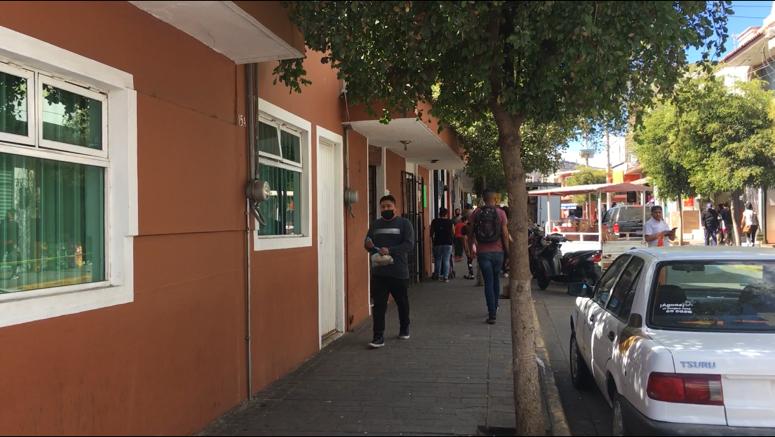
According to those affected, sales decreased by up to 85 percent during the first week. Photo: Héctor Ruiz.
Even though the new stalls designed for the merchants, which cost 7,500 pesos each, will not be charged to them, the vendors are looking for at least a support plan from the City Hall to ease them through this first phase of the change. However, such support has not been confirmed, which is why some of the vendors have been reluctant to move to the new space. The elevator installed after the remodel is not working, exacerbating the problem.
Some merchants opted to stop selling in the area, such as those who preferred to set up their vending stall outside their house on 499 Morelos Street in Nextipac, because their advanced age made climbing the stairs every day with their merchandise an impossible task.
The stairs have led to complaints from other merchants. Several told Laguna that «it has caused us more work to climb every day with all the product, it is very heavy».
The merchants who could not find a place inside the Market were hit even harder. They were relocated to the small square of «La Campana», a junction of Morelos and Independencia streets, which resulted in very low sales.
«Not even the flies can stop there», complained the vendors, who said that they will try to endure the situation as best they can in the hope that, with the passage of time and the force of habit, their former customers will come to their new facilities.
Meanwhile, since the relocation, the Government of Jocotepec began adding new signage to help rehabilitate Jocotepec’s urban image, damaged recently by the piles of garbage accumulated by the irregular collection service .
Translated by Patrick O’Heffernan
© 2016. Todos los derechos reservados. Semanario de la Ribera de Chapala
